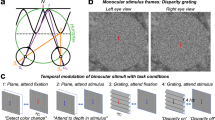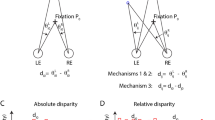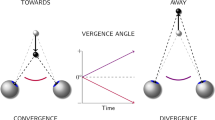Abstract
OBSERVATION of sinusoidal spatial modulation of luminance has proved a valuable tool in the study of visual processing of luminance distributions on the retina. Information on the limits of processing capability has been gained in such diverse fields as the optics of the eye1, neurophysiology of the retina2, movement3,4 and orientation5,6 sensitivity and cortical processing of spatial frequency7,8. In the field of stereoscopic vision, Blakemore9 and Fiorentini and Maffei10 have found that when luminance gratings of slightly different spatial frequencies were presented ,to each eye, an apparently tilted grating was perceived even if one monocular grating was moving quickly relative to the other. Furthermore, tilt is perceived from gratings of the same spatial frequency but differing in contrast by 50% or more. These phenomena are not easy to explain on the basis of disparities at corresponding retinal points, but seem to require more global processing of the whole image.
This is a preview of subscription content, access via your institution
Access options
Subscribe to this journal
Receive 51 print issues and online access
$199.00 per year
only $3.90 per issue
Buy this article
- Purchase on Springer Link
- Instant access to full article PDF
Prices may be subject to local taxes which are calculated during checkout
Similar content being viewed by others
References
Schadé, O. H., J. opt. Soc. Am., 46, 721–739 (1956).
Enroth-Cugell, C., and Robson, J. G., J. Physiol., Lond., 187, 512–552 (1966).
Pantle, A. J., and Sekuler, R. W., Vision Res., 8, 445–450 (1968).
Pantle, A. J., J. opt. Soc. Am., 60, 1120–1124 (1970).
Gilinsky, A. S., J. opt. Soc. Am., 58, 13–18 (1968).
Blakemore, C., and Campbell, F. W., J. Physiol., Lond., 203, 237–260 (1969).
Pantle, A. J., and Sekuler, R. W., Science, 162, 1146–1148 (1968).
Blakemore, C., and Sutton, P., Science, 166, 245–247 (1969).
Blakemore, C., Vision Res., 10, 1181–1199 (1970).
Fiorentini, A., and Maffei, L., Vision Res., 11, 1299–1306 (1971).
Julesz, B., in Information Theory: 4th Lond. Symp., 1960 (edit. by Cherry, E. C.) (Butterworth, London, 1961).
Julesz, B., and Payne, R. A., Vision Res., 8, 433–444 (1968).
Julesz, B., and Johnson, S. C., Proc. natn. Acad. Sci. U.S.A., 61, 437–441 (1968).
Tyler, C. W., Science, 181, 276–278 (1973).
Campbell, F. W., Proc. IEEE, 56, 1009–1013 (1968).
Julesz, B., Foundations of cyclopean perception (University of Chicago Press, Chicago, 1971).
Frisby, J. P., and Roth, B., Q. Jl exp. Psychol., 23, 367–372 (1971).
Author information
Authors and Affiliations
Rights and permissions
About this article
Cite this article
TYLER, C. Depth perception in disparity gratings. Nature 251, 140–142 (1974). https://doi.org/10.1038/251140a0
Received:
Revised:
Issue Date:
DOI: https://doi.org/10.1038/251140a0
This article is cited by
-
Human primary visual cortex shows larger population receptive fields for binocular disparity-defined stimuli
Brain Structure and Function (2021)
-
Spatial orienting of attention in stereo depth
Psychological Research (2012)
-
From optics to attention: visual perception in barn owls
Journal of Comparative Physiology A (2011)
-
Sensors for impossible stimuli may solve the stereo correspondence problem
Nature Neuroscience (2007)
-
Pupillary response induced by stereoscopic stimuli
Experimental Brain Research (2005)
Comments
By submitting a comment you agree to abide by our Terms and Community Guidelines. If you find something abusive or that does not comply with our terms or guidelines please flag it as inappropriate.



